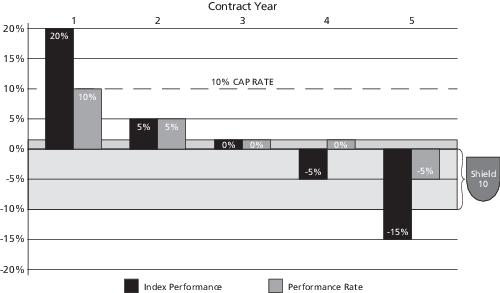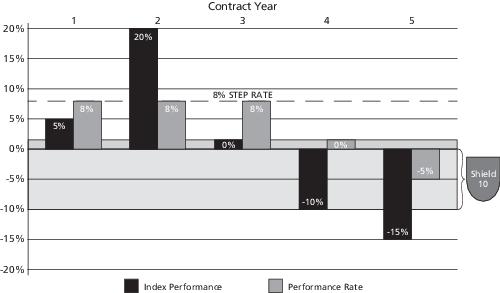the applicable Shield Option(s) will automatically transfer into the Fixed Account at the Term End Date, unless you instruct us
otherwise. The amounts transferred to the Fixed Account must remain in the Fixed Account until the Interest Rate Term End
Date (which, currently, will not be less than one (1) year). The Investment Amount held in the Fixed Account may earn a return
that is less than the return you might have earned if those amounts were held in a Shield Option. If we exercise this right, your
ability to increase your Account Value and, consequently, increase your death benefit will be limited. If the Fixed Account is not
available, the Investment Amount will automatically transfer into the Shield Option with, in order of priority, the shortest Term,
the highest Shield Rate and the lowest Cap Rate from the Shield Options available at the Term End Date, unless you instruct
us otherwise. A 3-Year Term will be available for at least the first six (6) Contract Years, subject to the transfer requirements.
Because the S&P 500
®
Index (Price Return Index), the Russell 2000
®
Index (Price Return Index) and the MSCI EAFE
Index (Price Return Index) are each comprised of a collection of equity securities, in each case the value of the component
securities is subject to market risk, or the risk that market fluctuations may cause the value of the component securities to go
up or down, sometimes rapidly and unpredictably. In addition, the value of equity securities may increase or decline for
reasons directly related to the issuers of the securities. (See “INDICES” and “SHIELD RATES.”)
We have the right to substitute a comparable index prior to the Term End Date if any Index is discontinued or, at our sole
discretion, we determine that our use of such Index should be discontinued, or if the calculation of an Index is substantially
changed. We would attempt to choose a substitute index that has a similar investment objective and risk profile to the
replaced index. Upon substitution of an Index, we will calculate your Index Performance on the replaced Index up until the
date of substitution and the substitute Index from the date of substitution to the Term End Date. An Index substitution will not
change the Shield Rate, Cap Rate or Step Rate for an existing Shield Option. The performance of the new Index may not be as
good as the one that it substituted and as a result your Index Performance may have been better if there had been no
substitution.
Our business is largely conducted through complex
information technology and communications
systems operated by
us and our service providers or other business partners (e.g., the firms involved in the distribution and sale of our products)
,
and their operations rely on the secure processing, storage and transmission of confidential and other information in their
systems and those of their respective third party service providers
. For example, many routine operations, such as processing
your requests and elections and day-to-day record keeping, are all executed through computer networks and systems. We
have established administrative and technical controls and business continuity and resilience plans to protect our operations
against attempts by unauthorized third parties to improperly access, modify, disrupt the operation of, or prevent access to
critical networks or systems or data within them (a “cyber-attack”). Despite these protocols, a cyber-attack could have a
material, negative impact on BLNY, as well as individual Owners and their Contracts.
There are inherent limitations in our
plans and systems, including the possibility that certain risks have not been identified or that unknown threats may emerge in
the future. Unanticipated problems with, or failures of, our disaster recovery systems and business continuity plans could
have a material impact on our ability to conduct business and on our financial condition and operations, and such events
could result in regulatory fines or sanctions, litigation, penalties or financial losses, reputational harm, loss of customers, and/or
additional compliance costs for us.
Our operations also could be negatively affected by a cyber-attack at a third party, such
as a service provider, business partner, another participant in the financial markets or a governmental or regulatory authority.
Cyber-attacks can occur through unauthorized access to computer systems, networks or devices; infection from computer
viruses or other malicious software code; phishing attacks; account takeover attempts; or attacks that shut down, disable,
slow or otherwise disrupt operations, business processes or website access or functionality. There may be an increased risk
of cyber-attacks during periods of geo-political or military conflict. Disruptions or failures may also result from unintentional
causes, such as market events that trigger a surge of activity that overloads current information technology and
communication systems. Other disruptive events, including (but not limited to) natural disasters, military actions, and public health crises, may adversely affect our ability to conduct business, in particular if our employees or the employees of our
service providers are unable or unwilling to perform their responsibilities as a result of any such event. Cyber-attacks,
disruptions or failures to our business operations can interfere with our processing of Contract transactions, including the
processing of transfer orders from our website; impact our ability to calculate values; cause the release and/or possible loss,

